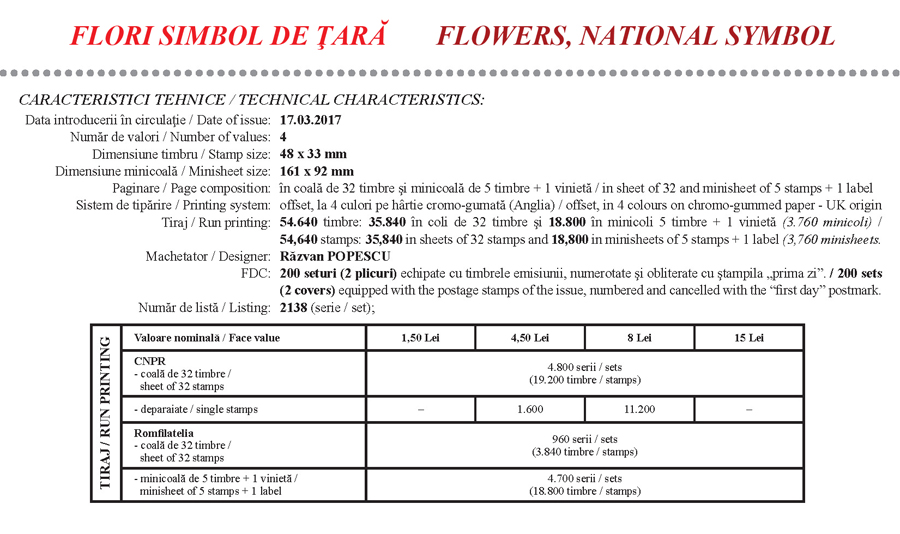Flora, a beloved theme for those passionate by philately, is once again taken up this year by Romfilatelia within the postage stamp issue “Flowers, National Symbol”. Together with the symbol flower of each state, the national flag completes the stamp illustration.
Romania is bordered by Bulgaria to the south, Serbia to the southwest, Hungary to the northwest, Ukraine in the north and east and Moldova to the east and the Black Sea to the southeast.
The peony whose image is reproduced on the stamp with the face value Lei 1.50 is a flower species unique to Europe. In the country there are five nature reserves for Paeonia peregrina in Teleorman, Mures, Olt, Dolj and Giurgiu.
Romania’s national symbol flower, the peony, is also known under the name of the Palm of the Lord’s Mother (verbatim). All its other names are popular, archaic and describe the Romanian peony.
In popular culture, the peony is often associated with longing, with physical beauty or love.
The symbol flower of the Republic of Moldova is the basil, whose image is reproduced on the stamp with the face value of Lei 4.50. To the left of the Prut it’s one of the most beloved and sung plants. Because of its special aromatic oils and its preservative properties, basil is used in the Orthodox Church rituals to produce holy water, having the role of chasing away evil spirits. At the same time, in local tradition this plant is considered the flower of love and luck; it is also present in most magical practices for marital purposes. In popular medicine, basil is used as a plant with talismanic properties for memory improvement and as an anti-stress remedy.
The Republic of Croatia’s national flower, illustrated on the stamp with the face value of Lei 8, is Iris croatica. The Croatian name for this flower is Perunika and comes from the name of Perun, who was the greatest god of thunder and lightning in Slavic mythology. Legend has it that Perunika will only grow in the place where the god Perun’s lightning struck.In 2000, the Croatian Academy of Arts and Sciences proclaimed the Perunika as Croatia’s national flower. Iris croatica is distinguished primarily from many other subspecies by the greatness of all its plant parts, the flowers being oval and richer. We can admire the beauty of the iris flowers in summer and autumn. About the gorgeous purple flower, herbalists claim that it is a simple remedy to keep a variety of diseases under control. The gorgeous flower that we find in gardens, parks and even in pots on terraces is a less known cure.
Bulgaria, a beautiful country in the Southeast European continent, has the rose as a national symbol.
Rosa damascena whose image is reproduced on the stamp with the face value of Lei 15 is a symbol of this country, considered a worldwide brand, and the wide range of cosmetics that have rose aromas are called “Bulgarian gold” or “liquid gold”.Rosa damascena or Kazanlak Rose is a highly fragrant flowering plant from which essential oil, confiture and syrup are extracted. From this variety of rose one can extract 30% more oil than of any other rose. The pink flowers have about 30 petals, hence the name of Trigintipetala.
Romfilatelia thanks the “Dimitrie Brandza” Botanical Garden of the University of Bucharest, the Republic of Moldova Embassy in Romania, the Republic of Croatia Embassy in Romania, the Republic of Bulgaria Embassy in Romania for their documentary support granted in the creation of this postage stamp issue.

















